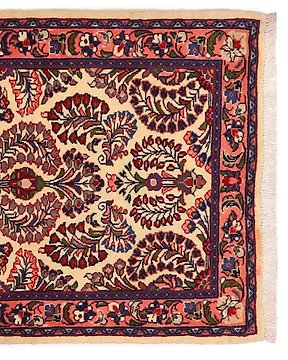
Persisk matta Sarouk - Matta - 137 cm - 68 cm
Nr 82071015

Nr 82071015

Origin: Iran Koliai (Kurdistan)
Knot density: approx. 120000-160000 knots/sqm
Condition: NEW (see photos)
Pattern: floral, symmetrical with medallion (very rare color combination)
Material: pile 100% virgin wool - warp 100% cotton from the Zagros mountains
Koliais are Persian tribal rugs made by Kurdish nomadic peoples in western Iran getting produced. They often stand out for the bright and vibrant colors they use. The Koliai often has a large central medallion with a classic Herati hexagonal diamond design and beveled corners within the main border. These rugs were not originally made for commercial sale. Rather, the women who knotted them followed an ancient custom that provided tribal families with handwoven items of practical value such as floor coverings, blankets, storage bags, saddlecloths, and financial security in case of future hardships. The Koliai rugs are a truly beautiful and vibrant collection that will keep a room looking beautiful for years to come.
History of the Koliai carpets
Kurdish carpets are made throughout western Iran, in and around the rugged mountainous region Kurdistan. The Kurds are descended from the ancient nomadic peoples who roamed the area thousands of years ago. They lead a semi-nomadic life, either in villages or in wandering tribes away from the cities, where they can still maintain their ancient traditions and live as they did thousands of years ago. Some of the Kurdish tribes in the western regions are the Herki, Senjabi, Gurani, Jaffid and Kalhors. Some important centers of Kurdish carpet production are Senneh, Bijar and the district of Khamseh. Other Kurdish villages and districts producing carpets are Borchelu, Goltogh, Khoi, Koliai, Lylyan, Mousel, Nanadj, Songhore, Touserkan and Zagheh. As you can see, the Kurds are an ancient semi-nomadic and/or nomadic people of Iran whose history dates back thousands of years. Many other important centers of carpet production in Iran, such as Hamadan, Lorestan or even Arrack, show clear traces of Kurdish influence. Sometimes the style and techniques of Iran's also widespread Turkish population are also adopted. The Kurds are a very peaceful and gentle group who prefer their simple nomadic life to the complexities and frustrations of the modern technological world.
Construction of Koliai carpets
Kurdish rugs, like all other Persian rugs, are 100% handmade. They are made from pure wool spun from the weaver's own sheep. On very rare occasions, a rug's pile may contain silk, and often the basis of a Kurdish rug is goat hair. However, the pile is always made of wool. The knot quality of Kurdish carpets varies between loose and dense knots, with the Persian asymmetrical knot being used more frequently than the Turkish symmetrical one. The colors are mainly achieved with natural vegetable dyes. The coloring of most Kurdish carpets is light and bright. Unlike most people in the Western world, who like faded and muted colors, Kurds love bright, vibrant colors. These exciting rugs bring life to the dreary homes of these common people. All Kurdish rugs are strong and durable as they have been proven for thousands of years.
The Songhor rugs are made of high-quality wool and are decorated in vegetable colors. Impressive are the large patterns where the primary color is red and shades of it.
The Koliai carpets got their name from the nomadic tribe of the same name. Koliai nomads live in villages southeast of the city of Senneh. The carpets are hard-wearing and have a dense pile. The vegetable colors give the very high quality wool shine. Impressive are the large patterns, where red and its shades are the main color.
Nomad Carpets: Carpets woven by nomads. Nomads move around constantly and do not stay in one geographic region permanently. They make (weave) handmade carpets on collapsible looms. Because of this, there can be slight variations in weaving, and their rugs are sometimes unevenly shaped. The weaving is also done from memory and depends on the momentary inspiration of the respective artist. As a result, the patterns of some rugs are not uniform across the entire surface.
"Errors and errors excepted"
Hur du köper på Catawiki
1. Upptäck något speciellt
2. Lägg det högsta budet
3. Gör en säker betalning